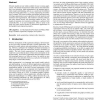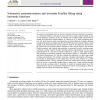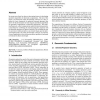SMA
2008
ACM
13 years 11 months ago
2008
ACM
In this paper we consider the problem of monitoring an art gallery modeled as a polygon, the edges of which are arcs of curves. We consider two types of guards: edge guards (these...
SMA
2008
ACM
13 years 11 months ago
2008
ACM
3D mesh models are now widely available for use in various applications. The demand for automatic model analysis and understanding is ever increasing. Mesh segmentation is an impo...
SMA
2008
ACM
13 years 11 months ago
2008
ACM
We present a framework for segmenting and storing filament networks from scalar volume data. Filament structures are commonly found in data generated using high-throughput microsc...
SMA
2008
ACM
13 years 11 months ago
2008
ACM
We present an alternative approach to standard geometric shape editing using physically-based simulation. With our technique, the user can deform complex objects in real-time. The...
SMA
2008
ACM
13 years 11 months ago
2008
ACM
We present an interactive algorithm for continuous collision detection between deformable models. We introduce two techniques to improve the culling efficiency and reduce the numb...
SMA
2008
ACM
13 years 11 months ago
2008
ACM
In this paper we present a new algorithm which turns an unstructured triangle mesh into a quad-dominant mesh with edges aligned to the principal directions of the underlying geome...
SMA
2008
ACM
13 years 11 months ago
2008
ACM
SMA
2008
ACM
13 years 11 months ago
2008
ACM
In recent years, there has been an increasing interest in developing geometric algorithms for kinematic computations. The aim of this paper is to present the notion of kinematic c...
SMA
2008
ACM
13 years 11 months ago
2008
ACM
Interactive visualization of massive models still remains a challenging problem. This is mainly due to a combination of ever increasing model complexity with the current hardware ...
SMA
2008
ACM
13 years 11 months ago
2008
ACM
This paper analyses the probability that randomly deployed sensor nodes triangulate any point within the target area. Its major result is the probability of triangulation for any p...



